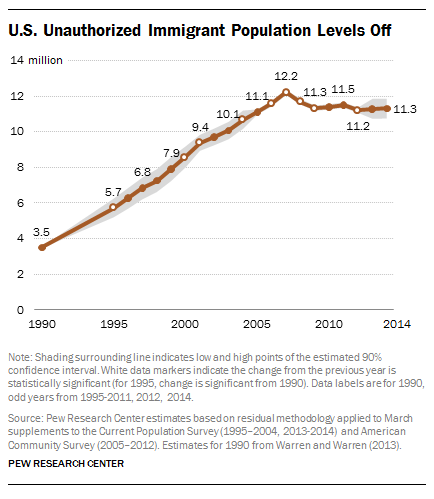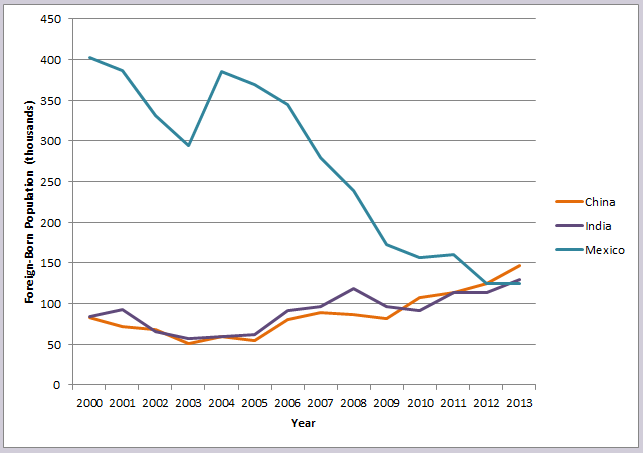Sign up for the daily CJR newsletter.
The stakes are high for immigration coverage. The Supreme Court is slated to rule this year on President Barack Obama’s executive actions, which could grant millions of unauthorized immigrants reprieve from deportation and the ability to apply for work permits. The political battle to succeed him, meanwhile, has been largely driven on the Republican side by Donald Trump’s calls for mass deportations and a more restricted border.
Level-headed reporting and analysis are all the more important with so much on the line. And three common narratives pose a particular threat to that coverage, often obscuring—rather than illuminating—a highly complex issue.
Framing unauthorized immigration as Mexican-specific
Media attention toward unauthorized immigration has long been trained on the southern border, partly in response to the millions of Mexicans who entered the United States in recent decades. But the trend line in recent years has pointed away from Mexico. Singular focus on that country serves to exclude millions of stakeholders from coverage.
Source: Pew Research Center
While it is true that those of Mexican origin account for more than half of the unauthorized population in the United States, more Mexicans are actually leaving the country than entering it. This outflow contrasts starkly with growing inflows from Asian and African countries, including India, China and Ethiopia, to name a few prominent examples.
Source: Migration Policy Institute
Some journalists produce important work that takes these shifts into account, shedding light on the diversity and demographic changes of unauthorized immigration. Yet the dominant narrative continues to frame the topic as Mexican-specific. Such tunnel vision is a detriment to understanding the issue in its entirety.
Casting Trump as a focal point
Unauthorized immigration has been the central issue of the GOP frontrunner’s campaign. But journalists’ natural attraction toward Trump—the man is a ratings machine—has often led them to frame stories around clashes between the real estate mogul and Mexico.
After Trump declared that Mexico is sending rapists and drug dealers over the southern border, news organizations responded with rebuttals from hard-working immigrants and analyses illustrating no correlation between immigrants and violent crime. Trump replied to this reporting by reiterating that he will not only build a wall along the border, but will make Mexico pay for it. Journalists further escalated tensions by asking former Mexican presidents to comment on Trump’s wall. He responded in kind, and so on.
It is in Trump’s interest to perpetuate such confrontations. And journalists, seizing on made-for-TV conflicts, have helped facilitate them. This back-and-forth between Trump and Mexico ultimately robs audiences of valuable information about the topic.
Pushing back on politicians is, of course, a key part of journalists’ collective role. When coverage revolves around such tension, however, it only serves to stoke existing flames. Journalists should correct the record and move on. More time and energy should be directed toward providing a more nuanced understanding of the unauthorized population.
Failing to contextualize individual narratives
A compelling story often requires a strong protagonist. Devoid of context, however, even powerful profiles of unauthorized immigrants can leave audiences with a myopic view.
This MSNBC feature, for instance, depicts a hard-working man who is devoted to his family. But it fails to address the root causes of his situation, leaving the moving portrait incomplete.
“There is a kneejerk tendency to choose the most obvious active party, to focus solely on the perceived perpetrator, without any effort to understand the [broader] factors,” says Roberto Suro, co-editor of Writing Immigration: Scholars and Journalists in Dialogue.
That practice is by no means unique to immigration coverage. But the issue’s intricate web of causes and effects makes the gravitation toward individual narratives potentially more dangerous. “Ultimately,” Suro says, “this perpetuates the idea that the power of immigrants to determine outcomes is equal or of even greater than the socioeconomic milieu in which they operate.”
In contrast, Luke Mogelson’s recent piece on an Honduran deportee weaves together all of the forces shaping the man’s life: the protagonist’s relationships with his family and employer; U.S.-backed civil wars in Central America in the 1980s; the proliferation of street gangs in Los Angeles; and his subsequent deportation to Honduras. Taken together, these elements provide readers with a fuller picture of one immigrant’s life and, in turn, of unauthorized immigration as a whole.
This is difficult and expensive to do, of course—Mogelson’s piece ran around 8,000 words. But his measured approach outlines best practices for fitting individuals within broader trends, which is especially important given the nature of debate over unauthorized immigration.
“The best defense when covering a realm that is so very polarized and politicized is trying to report on the larger context in which each story plays out,” Nina Bernstein, a New York Times reporter who covered immigration for five years, writes in an email. “That may have to do with the conditions migrants left, the businesses hiring them [or] the history of national policy toward immigration.”
A tilt toward more measured coverage could potentially help push the national conversation on this issue forward or, at the very least, minimize tropes often seen in this sharply divided debate.
Has America ever needed a media defender more than now? Help us by joining CJR today.








